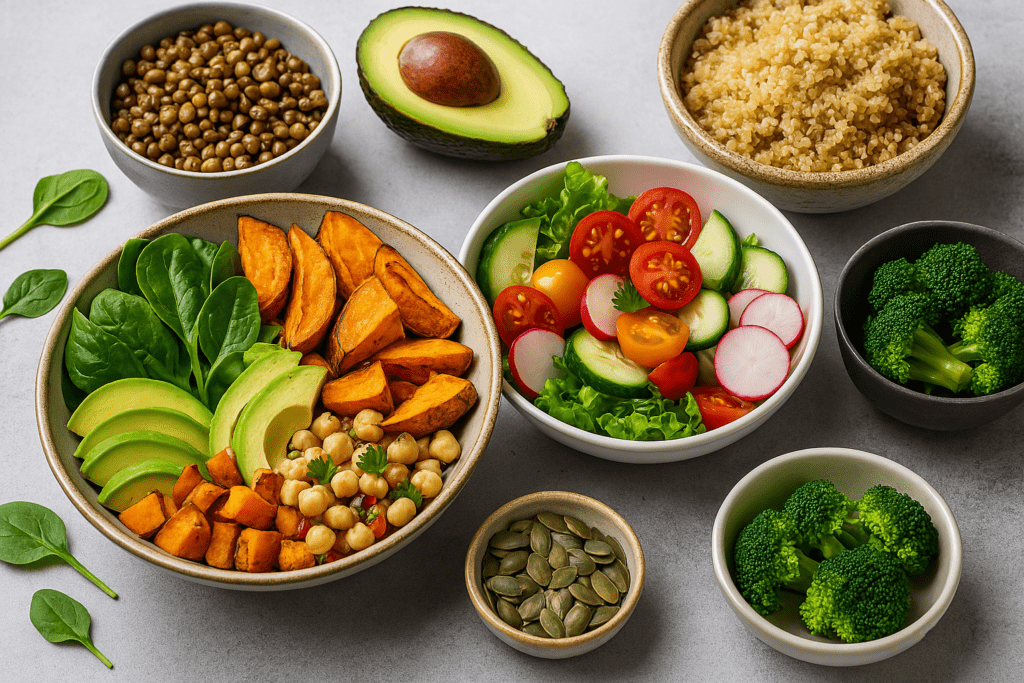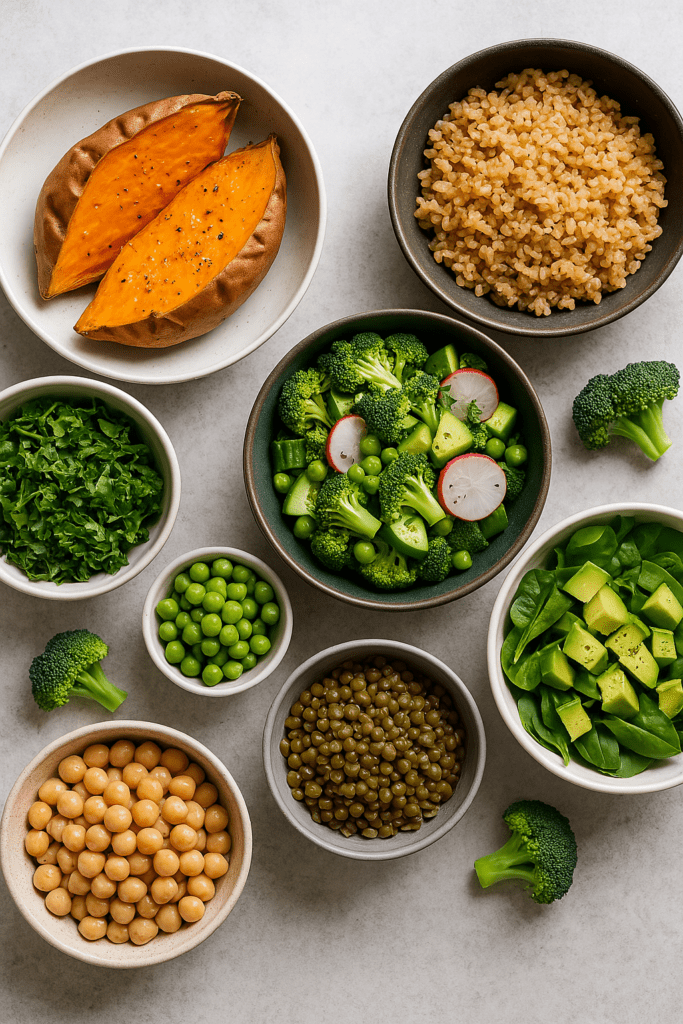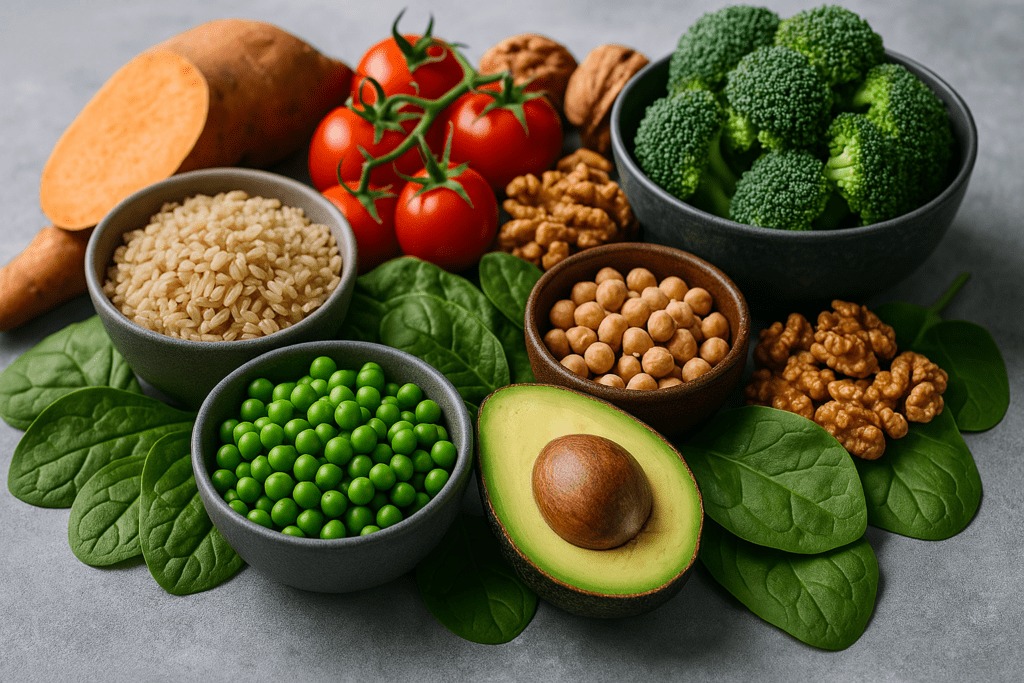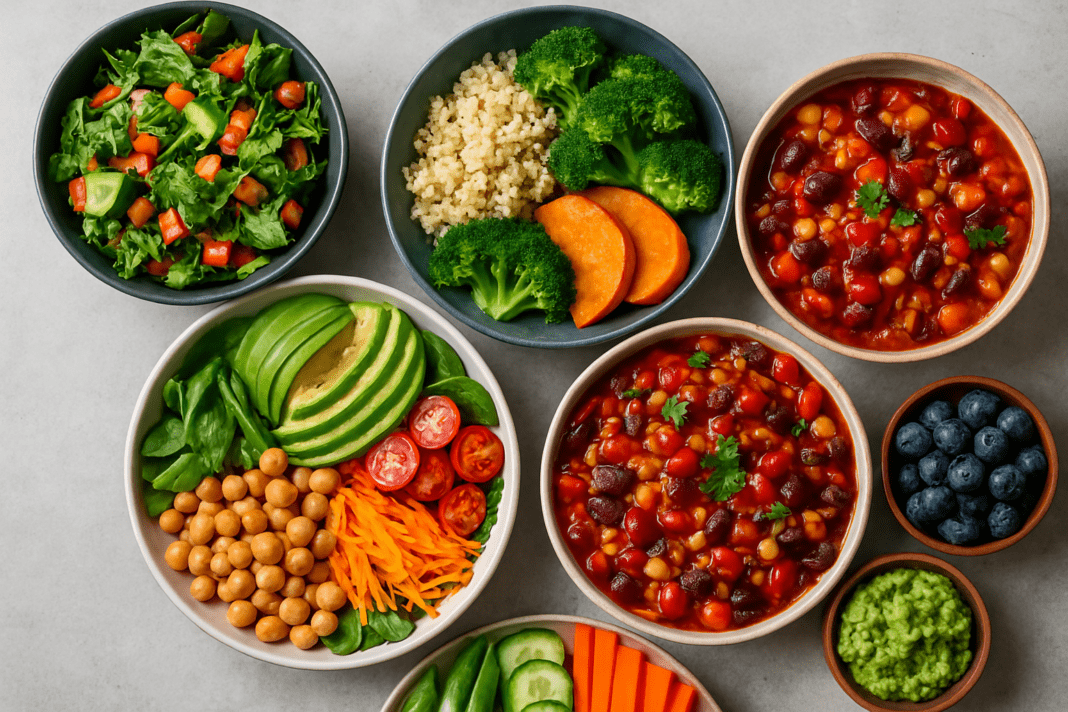For those navigating the complexities of managing diabetes through diet, the question of what to eat is both urgent and challenging. With a surge in research supporting the benefits of plant-based eating patterns, many are turning to whole-food, plant-based diets as a path to better health and more stable blood glucose levels. But for people living with diabetes, especially type 2 diabetes, there are important nuances to understand when creating a balanced, sustainable, and nutritionally sound diabetic meal plan. This comprehensive guide explores what diabetics can eat on a whole-food plant-based diet, offering evidence-based insights into food choices, timing, nutrient needs, and practical applications for everyday life.
You may also like: How a Plant-Based Diet May Help Reduce Cancer Risk: What Science Says About Nutrition and Tumor Prevention
Understanding the Diabetic Diet: Foundations for Stability and Health
The diabetic diet is not a one-size-fits-all prescription but rather a flexible framework centered around blood sugar regulation, cardiovascular protection, and long-term metabolic health. At its core, the goal is to stabilize blood glucose levels while supporting nutrient density, satiety, and energy balance. Whole-food plant-based diets, which emphasize unrefined plant foods such as vegetables, fruits, whole grains, legumes, nuts, and seeds, align naturally with these objectives. For those with type 2 diabetes, this approach can reduce insulin resistance, support weight management, and potentially reverse some metabolic dysfunctions.
Central to the diabetic diet plan is glycemic control. Foods that are low on the glycemic index (GI) help prevent spikes in blood sugar and promote smoother glucose curves throughout the day. These include legumes like lentils and chickpeas, whole grains like steel-cut oats and quinoa, and non-starchy vegetables such as leafy greens and cruciferous plants. Studies have shown that such choices, when incorporated into a structured diabetic diet food list, can significantly improve HbA1c levels and overall glycemic management. Yet beyond food type alone, the structure and timing of meals—the broader diabetes diet meal plan—play a pivotal role in achieving optimal outcomes.

Navigating the Diabetic Diet Food List: What Should Diabetics Eat?
When designing a diabetes-friendly plant-based menu, understanding what should diabetics eat is the first step in building a strong foundation. An ideal diabetic diet food list emphasizes fiber-rich vegetables, whole grains, and legumes. Fiber not only slows glucose absorption but also supports satiety and gut health, which are integral to maintaining a healthy weight—a key factor in diabetes management. Leafy greens such as kale, spinach, and collards, as well as cruciferous vegetables like broccoli and Brussels sprouts, are particularly effective in this regard.
What vegetables are good for diabetics extends beyond the usual leafy greens. Root vegetables like carrots and beets, when consumed in moderation and within balanced meals, offer antioxidants and essential vitamins without destabilizing blood sugar levels. Similarly, low-sugar fruits such as berries, apples, and citrus can be part of the diabetic meal plan, especially when paired with protein or healthy fats to modulate glycemic impact. Nuts, seeds, and tofu provide these essential fats and plant-based proteins, helping to create balanced meals that align with the best diet for diabetics.

Avoiding Blood Sugar Spikes: What Foods to Avoid with Diabetes
Equally important to knowing what foods to eat is understanding what foods to avoid with diabetes. Refined carbohydrates, such as white bread, pastries, and sugary cereals, are known to cause rapid spikes in blood sugar and should be minimized or eliminated. These foods not only contribute to postprandial hyperglycemia but also lack the nutrients necessary for sustained energy and metabolic balance. Added sugars, particularly those in sweetened beverages and processed snacks, are especially harmful for individuals with diabetes and prediabetes.
Moreover, highly processed plant-based foods marketed as meat alternatives often contain refined oils, added sugars, and excess sodium—elements that can undermine the benefits of a whole-food plant-based approach. Understanding which foods contribute to high A1C can empower individuals to make informed choices that support long-term glycemic control. The diabetic diet plan should steer clear of such products and instead focus on preparing meals from whole, minimally processed ingredients.

Constructing a Diabetic Meal Plan: Balancing Macronutrients and Timing
A thoughtful diabetic meal plan involves more than just choosing the right foods; it also requires attention to portion sizes, meal composition, and timing. Each meal should include a balance of complex carbohydrates, plant-based proteins, and healthy fats. This trifecta helps modulate the post-meal glucose response and promotes longer-lasting satiety. For example, a well-rounded breakfast might consist of steel-cut oats topped with chia seeds, blueberries, and a handful of walnuts. Such a combination aligns with diabetes diets diabetic food chart guidelines and supports sustained energy release.
Meal scheduling also plays a role in glucose management. A consistent meal schedule for diabetics—eating meals and snacks at regular intervals—helps prevent both hyperglycemia and hypoglycemia. Ideally, individuals should aim for three balanced meals per day with one or two small snacks, depending on their medication regimen and activity level. This structure allows for better predictability in blood sugar trends and reduces the risk of sudden fluctuations.
Identifying Free Foods and Smart Snacks: What Foods Can Diabetics Eat Freely?
The concept of “free foods”—foods that contain minimal calories and carbohydrates—is particularly useful in crafting a satisfying and sustainable diabetic diet. These include non-starchy vegetables like cucumbers, celery, radishes, mushrooms, and leafy greens. Understanding the list of free foods for diabetics allows for flexible meal planning and healthy snacking without compromising blood sugar control. These options also contribute valuable phytonutrients and hydration to the overall diet.
In the context of snacks, choosing nutrient-dense options that offer fiber, protein, or healthy fats can help curb hunger between meals while keeping blood glucose stable. Examples include hummus with raw vegetables, a small apple with almond butter, or roasted chickpeas. When developing an eating plan for prediabetes or type 2 diabetes, these snacks play a critical role in maintaining energy and preventing cravings that could lead to poor food choices.
The Role of Vegetables for Diabetics: Powerhouse Foods for Blood Sugar Balance
Vegetables for diabetics serve as the cornerstone of any effective plant-based diabetes meal plan. Beyond their fiber content, vegetables offer antioxidants, phytonutrients, and anti-inflammatory compounds that help protect against the complications of diabetes. Dark leafy greens, cruciferous vegetables, and colorful non-starchy options contribute to insulin sensitivity and cellular health. For example, compounds in broccoli and Brussels sprouts support detoxification pathways and reduce oxidative stress—both relevant to diabetes-related inflammation.
What vegetables can diabetics eat? In addition to leafy greens and cruciferous options, consider bell peppers, tomatoes, zucchini, eggplant, and green beans. These foods are versatile, flavorful, and low in calories, making them ideal for weight management—a crucial consideration in both type 2 diabetes and prediabetes diet plans. The variety in color and texture also makes meals more appealing, increasing adherence to dietary changes.
Type 2 Diabetes Diet Considerations: Individualized and Evidence-Based Approaches
The type 2 diabetes diet must be tailored to each individual’s health status, lifestyle, and preferences. While general guidelines are helpful, personalized adjustments based on blood sugar response, energy needs, and comorbidities ensure greater success. Monitoring how different foods affect personal glucose levels—using tools like continuous glucose monitors or finger-stick testing—can refine food choices and meal patterns.
Nutritional adequacy is also a key consideration. Plant-based eaters with diabetes must ensure they meet their needs for nutrients such as vitamin B12, iron, calcium, and omega-3 fatty acids. Fortified foods or supplements may be required in some cases. However, with proper planning, a whole-food plant-based approach can provide all essential nutrients while supporting better blood sugar control. When asking what is the best diet for a diabetic person, a tailored, nutrient-dense, plant-based diet often emerges as a leading answer, supported by growing clinical evidence.
What to Eat to Lower Blood Glucose: Strategic Food Pairings and Nutrient Timing
When blood sugar runs high, knowing what to eat to lower blood glucose becomes a critical skill. Strategic food pairings—combining fiber-rich carbohydrates with protein and fat—can slow glucose absorption and mitigate spikes. For example, pairing sweet potatoes with black beans and avocado creates a satisfying, glycemic-friendly meal. Similarly, oats with ground flaxseed and a side of edamame or tofu offer a blend of macronutrients that helps maintain blood sugar stability.
What food to eat to lower sugar level also depends on the time of day and physical activity. Post-exercise meals, for instance, should include complex carbs and protein to replenish glycogen without causing large spikes. When choosing what to eat when sugar is high, focus on hydrating, low-GI foods such as cucumber, leafy greens, and unsweetened plant-based yogurt with chia seeds. These support gentle glucose reduction without overcorrection.
Managing Prediabetes: Crafting an Effective Prediabetes Diet Plan
A prediabetes diet plan mirrors many aspects of the diabetic diet, emphasizing blood sugar stabilization, weight control, and metabolic health. For individuals in the prediabetic range, early dietary intervention can prevent or delay progression to type 2 diabetes. Embracing a whole-food, plant-based diet that emphasizes legumes, vegetables, and whole grains is a highly effective strategy. Reducing the intake of processed foods and added sugars is paramount.
What foods contribute to diabetes include not only obvious culprits like soda and candy but also hidden sources of sugar and refined grains found in packaged goods. Reading labels and cooking at home allows for greater control and awareness. As with diabetes, the prediabetes food plan should include a balance of macronutrients, a regular meal schedule, and nutrient-rich snacks that prevent energy crashes and cravings.
Designing a Practical Diabetes Diet Meal Plan: From Theory to Everyday Practice
Translating these principles into daily life requires preparation, flexibility, and a clear understanding of food composition. A successful diabetes diet meal plan might include a breakfast of tofu scramble with spinach and whole grain toast, a lunch of lentil soup and mixed greens, and a dinner of quinoa with roasted vegetables and tahini dressing. Snacks could include a handful of almonds or carrot sticks with hummus. These meals align with the best diet for diabetics, offering balance, variety, and consistency.
For those wondering what foods are good to lower blood sugar, focusing on fiber-rich legumes, antioxidant-rich vegetables, and healthy fats like avocado and flaxseed can offer daily support. By keeping meals consistent and avoiding skipped meals, the risk of erratic blood sugar levels is minimized. With time, what began as a structured diet evolves into a lifestyle marked by mindfulness, nourishment, and vitality.
Frequently Asked Questions: Whole-Food Plant-Based Diets for Diabetics
1. Can a diabetic diet still include occasional indulgences without disrupting blood sugar control?
Yes, a diabetic diet can accommodate occasional indulgences, provided they are planned mindfully and integrated within an overall balanced diabetic meal plan. For example, a small serving of dark chocolate or a naturally sweetened plant-based dessert can be paired with high-fiber foods to blunt glucose spikes. Understanding what can diabetics eat freely and what foods to avoid with diabetes empowers individuals to manage occasional treats without guilt. These indulgences should never replace nutrient-dense foods on the diabetic diet food list but can help sustain long-term adherence to a type 2 diabetes diet. Practicing portion control and timing indulgences around physical activity can further help prevent blood sugar fluctuations.
2. How can someone transition from a standard diabetic diet to a whole-food plant-based version without feeling overwhelmed?
Transitioning to a whole-food plant-based diabetic diet plan is best approached gradually to avoid burnout. Begin by replacing one meal per day—such as breakfast—with a plant-based alternative that aligns with your diabetes diet meal plan, such as oatmeal with flaxseed and berries. Over time, add more vegetables for diabetics and swap refined carbs with legumes and whole grains from a trusted diabetic diet food list. Creating a structured meal schedule for diabetics helps ease the transition and reduce anxiety around food choices. Support from a registered dietitian can also provide individualized guidance and help build confidence in new eating patterns.
3. Are there specific emotional or psychological benefits to following a whole-food plant-based diabetic diet?
Absolutely. Many individuals report improvements in mood, energy levels, and self-efficacy after adopting a plant-based diabetic diet plan. The clarity that comes from knowing what foods should be avoided by diabetics—and what foods to eat to lower blood sugar—often reduces food-related anxiety. Additionally, the predictability of a consistent meal schedule for diabetics can support mental well-being by minimizing decision fatigue. As blood sugar levels stabilize, mood swings and energy crashes often decrease, which can positively affect emotional health. A sense of empowerment often accompanies the shift toward the best diet for diabetics, reinforcing long-term commitment.
4. Can cultural or ethnic food traditions be honored within a plant-based diabetes diet meal plan?
Yes, traditional foods from various cultures can be beautifully integrated into a diabetes diet meal plan that is both plant-based and supportive of blood glucose control. For instance, lentil dal, black bean stew, and Mediterranean chickpea dishes are naturally rich in fiber and align well with a prediabetes diet plan. Adjusting recipes to minimize oils and added sugars, and understanding which foods contribute to high A1C, can help preserve the flavors of cultural cuisine while maintaining metabolic health. A flexible diabetic meal plan should respect individual backgrounds and make room for meaningful, family-oriented meals. In fact, cultural familiarity often increases dietary adherence and long-term satisfaction.
5. How can athletes or highly active individuals with diabetes meet their energy needs on a plant-based diet?
For active individuals following a type 2 diabetes diet, energy and nutrient demands are higher and should be met strategically. Incorporating calorie-dense yet glycemic-friendly foods like quinoa, nuts, avocados, and legumes can support performance without compromising blood sugar. Timing meals around exercise is key—knowing what to eat when sugar is high or low can help avoid extremes during training. Sports drinks and energy gels may spike glucose, so athletes may benefit more from natural fuel like bananas, dates, or whole grain toast paired with protein. Tailoring the diabetic diet food list to physical demands ensures optimal function and recovery while keeping diabetes diets diabetic food chart goals in mind.
6. What are some overlooked foods that can support a diabetic diet but aren’t commonly recommended?
Several underutilized foods can be powerful additions to a diabetic meal plan. Tempeh, for example, offers fermented plant-based protein with gut-health benefits that may aid insulin sensitivity. Sea vegetables like dulse and nori are low in carbohydrates and high in micronutrients, making them excellent for a diabetic diet food list. Artichokes, jicama, and fennel are lesser-known vegetables for diabetics that provide fiber and support digestion. Teff and sorghum are nutritious grains that deserve more attention in a diabetic diet plan due to their low glycemic impact. Expanding the palette with such foods adds diversity and improves the nutritional profile of a plant-based diabetic diet.
7. What strategies help with portion control while still feeling satisfied on a diabetic diet?
Portion control is easier when meals are structured with volume-rich, low-calorie foods. For example, adding leafy greens and cruciferous vegetables for diabetics can create larger plates without increasing glycemic load. Pairing complex carbs with fat and protein—as in a quinoa and black bean bowl with avocado—helps sustain satiety. Mindful eating practices, such as slowing down, chewing thoroughly, and eating without distractions, are particularly useful when following a diabetes diet meal plan. Using a visual plate model or a diet chart for diabetic patient planning can help maintain consistent portion sizes and reinforce nutritional balance. Satisfaction comes not just from fullness but from balanced blood sugar and steady energy levels.
8. How can people handle social situations like eating out or gatherings while following a strict diabetic diet plan?
Navigating social settings on a diabetic diet requires preparation, flexibility, and self-advocacy. Reviewing restaurant menus in advance allows for smart substitutions that align with the best diet for diabetics. Bringing a dish to gatherings ensures there is at least one blood sugar-friendly option, such as a lentil salad or roasted vegetable platter. Learning what foods can diabetics eat freely versus what foods should be avoided by diabetics helps make confident choices in uncertain environments. Social support is vital—informing close friends and family about your dietary needs can reduce pressure and foster understanding. Empowered by planning and education, people can enjoy social experiences without compromising their diabetic diet food list.
9. How does stress impact the effectiveness of a diabetes diet meal plan?
Stress can significantly undermine the benefits of even the most well-planned diabetes diet meal plan. Cortisol, the primary stress hormone, elevates blood glucose levels and can trigger cravings for high-sugar or high-fat foods—often the very foods that contribute to diabetes. Practicing stress-reduction techniques like deep breathing, yoga, or mindfulness supports both emotional balance and dietary discipline. Establishing a consistent eating plan for prediabetes or diabetes—along with a stable meal schedule for diabetics—provides a sense of control and structure that helps buffer stress responses. Managing stress is an essential, often underestimated component of a successful diabetic diet plan.
10. What future innovations might improve how we approach diabetic diets?
Emerging technologies like personalized nutrition platforms, AI-driven glucose prediction models, and microbiome testing are shaping the future of diabetic meal planning. These tools can refine the diabetic diet food list based on individual responses rather than general guidelines. There is growing interest in how gut bacteria influence glucose metabolism and what foods contribute to diabetes through microbial pathways. Innovations may soon allow for real-time feedback on what food to eat to lower sugar level, tailored not just to type 2 diabetes diet needs, but to the unique biochemistry of each person. As the science of precision nutrition evolves, the best diet for diabetics may become increasingly individualized and effective.
Conclusion: Embracing a Whole-Food Plant-Based Lifestyle for Lifelong Diabetes Support
Building a sustainable, whole-food plant-based diabetic meal plan requires more than selecting the right ingredients; it involves embracing a lifestyle rooted in intentionality, nourishment, and evidence-based choices. Understanding what can diabetics eat is only the beginning. From learning what vegetables are good for diabetics to recognizing what foods should be avoided by diabetics, the journey toward balanced blood sugar is filled with opportunities for empowerment and health.
Whether you are managing type 2 diabetes, crafting a prediabetes food plan, or simply aiming to optimize your metabolic health, the principles outlined here provide a solid foundation. A structured meal schedule for diabetics, paired with strategic food pairings and the mindful inclusion of free foods, creates an environment where blood sugar can remain stable, energy levels can improve, and long-term outcomes can shift in a positive direction. As science continues to affirm the benefits of plant-based nutrition, the path forward becomes clearer—and more hopeful—for those living with diabetes.
Through conscious food choices, consistent meal patterns, and a commitment to whole, minimally processed ingredients, individuals can redefine what it means to thrive with diabetes. A whole-food plant-based diet is not simply a set of restrictions; it is a toolkit for vitality, healing, and lifelong balance.
plant-based nutrition for diabetes, whole food meals for blood sugar, insulin resistance diet strategies, glycemic index plant foods, natural blood sugar control, fiber-rich meals for diabetics, plant-based protein sources, anti-inflammatory foods for diabetes, plant-based eating and metabolism, diabetic-friendly whole grains, heart-healthy diabetic meals, vegan recipes for blood sugar, reversing insulin resistance naturally, plant-based lifestyle for diabetics, blood sugar friendly snacks, glucose-lowering meal prep, managing A1C with diet, sustainable diabetic nutrition, non-starchy vegetable recipes, healthy plant fats for diabetes
Further Reading:
Diabetes Diet Basics: How to Get Started
A plant-based diet for the prevention and treatment of type 2 diabetes
16 Best Foods for People with Diabetes
Disclaimer
The information contained in this article is provided for general informational purposes only and is not intended to serve as medical, legal, or professional advice. While NewsHealthWatch strives to present accurate, up-to-date, and reliable content, no warranty or guarantee, expressed or implied, is made regarding the completeness, accuracy, or adequacy of the information provided. Readers are strongly advised to seek the guidance of a qualified healthcare provider or other relevant professionals before acting on any information contained in this article. NewsHealthWatch, its authors, editors, and contributors expressly disclaim any liability for any damages, losses, or consequences arising directly or indirectly from the use, interpretation, or reliance on any information presented herein. The views and opinions expressed in this article are those of the author(s) and do not necessarily reflect the official policies or positions of NewsHealthWatch.

